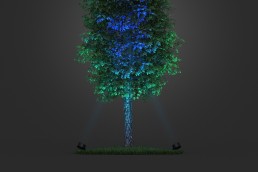
David Morgan Review: Hydrel FLAME
David Morgan takes a closer look at the LIT Award winning FLAME from Hydrel – one of the most technically sophisticated exterior architectural lighting companies in the world.
When a company that started life in California in the early 1960s by setting out to develop the best and most reliable underwater lighting system then continues to innovate to this day, in the 21st century by recently creating a novel approach to colour mixing luminaires, I thought that further investigation was needed.
Hydrel, now part of the Acuity Brands group, has grown into one of the most technically sophisticated exterior architectural lighting companies with a wide range of surface mounted, inground, and underwater luminaires. Components are produced and products assembled in-house with manufacturing sites in Crawfordsville, Indiana, and Winona, Minnesota.
One of the latest product developments from Hydrel is the FLAME range, based on the successful SAF range of DMX controlled RGBW projectors. The FLAME range adds separate control of two sets of RGBW light engines to produce novel dual colour lit effects. The range received the LIT award in 2023 for Lighting Product Design of the Year.
It is surprising how sometimes it is the simple ideas that can be the most effective. Who would think that providing a double set of DMX addresses for a single RGBW luminaire would produce such interesting and attractive lit effects?
However, it is interesting to note that Hydrel includes a prominent note on the FLAME micro-site saying that the effects produced are intentional in case the viewer might get the impression that the effect was caused by a problem with the colour control or optics.
The range consists of three sizes of projector, each with three distributions. The smallest size – the SAF7F RGBW, which I tested – incorporates seven RGBW light engines fitted with 45mm colour mixing lenses. The seven light engines are controlled separately in two groups to produce the unique dual colour lit effects.
The narrow distribution gives a centre beam angle of 10° with three light engines and an outer beam of 30° with four light engines. The two sets of light engines are independently controllable. The wide distribution gives a centre beam angle of 30° with an outer cone of 70°. The third distribution, called Lotus, combines 10° centre beam with 70° for the outer cone, which produces the most obvious colour separation from the two sets of light engines.
Hydrel has included a useful and engaging visualiser on the FLAME micro web site where the user can adjust the beam type, adjust each light engine individually, and also show the lit effect from various viewpoints, on different wall surfaces, including white paint, stone, and red brick.
Hydrel give lumen output figures for the two groups of light engines separately. The highest output is for the narrow distribution with 823 lumens at the centre and 730 for the outer. This size of luminaire runs at 46 system Watts, giving a reasonable overall efficacy for an RGBW luminaire.
The next size up is the SAF14F RGBW with 14 light engines, delivering a maximum total lumen output of 2,699lm with a power consumption of 64.7W.
The largest size in the range is the SAF28F RGBW with 28 light engines, providing a maximum total lumen output of 4,949lm with a power consumption of 165W. The overall diameter of the luminaire body is 406mm and is designed for use on larger projects.
The SAF7F sample I was given to test came with the Acuity Fresco controller, so I was easily able to adjust the colour and intensity of the two sets of light engines. The colour blending lenses worked well and there were no colour separated shadows from each light engine. The industrial and engineering design of the SAF FLAME luminaires is sophisticated and well detailed. A wide range of mounting and glare control accessories is available, and the luminaires incorporate well considered luminaire adjustment locking features. The die cast luminaire components are of high quality with concealed fixings. Two four-channel DMX drivers are housed within the luminaire to give the eight DMX addresses.
According to Chris Sorensen, Senior Director of Engineering at Hydrel, who led the FLAME development team, the motivating idea behind the development of the FLAME range was being inspired by projection art installations while simultaneously feeling tired of saturated RGB colour chases. The team members challenged themselves to build a new tool with which to ‘paint the night’ in a new way.
Apparently the first FLAME mock-ups were done using Photoshop, where images of two beams were arranged on top of each other so that the colour and blending of the beams could be independently controlled. It is understood that considerable effort was needed to develop the optical system to produce the best colour mixes for each distribution while avoiding disturbing artifacts. A patent is pending for the optical system used in the FLAME range.
I look forward to seeing further developments of the FLAME system and to seeing the projects where the unique lit effects have been used to the greatest advantage.



